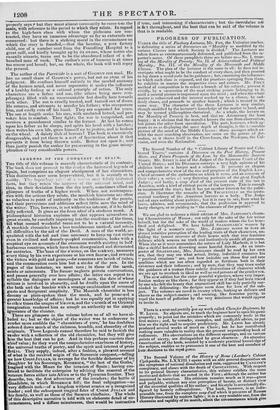LEGENDS OF THE CONQUEST OF SPAIN.
THE title of this volume is scarcely characteristic of its contents. The look does not present to the reader the historical legends of Spain, but comprises an elegant abridgment of her chroniclers. This distinction may seem hypereritical, but it is scarcely so in
reality. The legmlnry of a nal; el may falsify historical facts, but they retain the impress of the national mind, and thus, in their deviation from the dry truth, sometimes afford us glimpses of truths of a higher reach. When not contempora- ries with the actions they relate, the monkish historians are often as valueless in point of authority as the traditions of the people, and their perversions and additions reflect little save the mind of the writer. This, however, is not without an interest, if it be faith- fully reflected. It gives us the beau ideal of a studious monk. A philosophical historian explains all that appears miraculous in great events, by carefully inquiring into the condition of the times, till what seemed wonderful turns out to be a ratural necessity. A monkish chronicler has a less troublesome method, and solves all difficulties by the aid of the Devil. A man of the world, ac- quainted with the toil and time necessary to heap up vast riches even in civilized and densely-peopled communities, looks with a sceptical eye on accounts of the enormous wealth existing in half- barbarous countries, which have been disorganized and devastated for centuries. Thelnan of the c'oister, on the contrary, measures every thing by his own experience or his own fancied, and rewards the victors with gold and gems,—for romances are lavish of riches, and the enumeration costs him but a stroke of the pen. In the pages of the historian, we meet men ; in those of the monk, saints or miscreants. The former neglects private conversations, and passes generally over love affairs; the latter can repeat to a syllable the dialogues or monologues of men, the date of whose actions is involved in obscurity, and he dwells upon the sacra of the bath and the boudoir with a strange combination of reverend gusto and Scriptural simplicity. The Moorish chronicler is less dreamy or plain-spoken than the monk, and he possessed a greater knowledge of affairs ; but he was equally apt in applying to other times the usages of his own, and the warmth of an Oriental imagination rendered him as unsafe an authority as the simple ignorance of the cloister.
There are glimpses in the volume before us of all we have al- luded to ; but as the object of the writer was to endeavour to render more credible the "chroniclers of yore," he has doubtless sobercd down much of the richness, breadth, and absurdity of the originals. These Legends cannot therefore be said to furnish the reader with a reflection of the old chronicler, but they will give him the best that can be got. And in this perhaps consists their chief value; for they want the comprehensive exactness of history, the universal truths of poetry, and the spirit and interest of prose fiction. They supply, indeed, after a fashion, a pleasant account of what is the received origin of the Samcenic conquest,—telling us how Count JULIAN, in revenge for the forcible dishonour of his ' daughter by his Sovereign, RODERICK, "the last of the Goths," leagued with the Moors for the invasion of Spain ; having con- ,trived to facilitate the enterprise by advising the removal of the veteran forces either into Africa or to the Pyrenean frontier. They describe, too, the first adventures of the invaders ; the battle of Guadalete, in which RODERICK fell; the final subjugation—no very difficult task—of a kingdom without armies or a recognized leader ; and the subsequent tragical fates of Count JULIAN and his family, as well as those of the Saracen chieftains. The whole of this descriptive narrative is told with an elaborate detail of cir- eumstances, and a diffuse minuteness, that would be instructive
if true, and interesting if characteristic ; but the incredulas odi is fe't throughout, and the best that can be said of the volume is that is is readable.


























 Previous page
Previous page